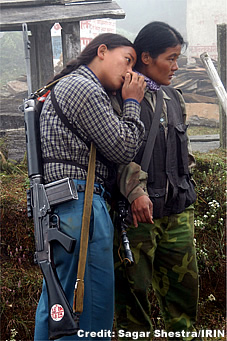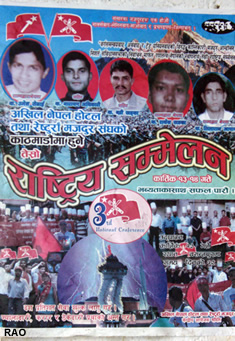Former
Maoist rebels have been accused of extortion and intimidation
"The situation is much worse today than during the armed conflict because then we had to deal with only one group of rebels, but now there are many," said a local businessman who requested anonymity for fear of being targeted. Maoists Former Maoist rebels joined the interim government in April 2007 and disarmament and demobilisation are proceeding under UN supervision. However, activists of the local human rights group Informal Sector Service Centre (INSEC) say many ex-rebels are out in the streets helping the Maoist-affiliated Youth Communist League (YCL), trade unions and dozens of other Maoist-affiliated organisations. "The Maoists force us to pay donations almost every month and this is extremely frustrating, with the government being unable to do anything," said an industrialist who preferred anonymity. Senior Maoist leaders have denied involvement in extortion, while government officials said they have been putting pressure on the Maoists to stop any illegal activities. Madhesi protests In addition, protests and strikes by various pro-Madhesi groups in the Terai region - a densely populated strip of lowland in southern Nepal running adjacent to the Indian border which is the agricultural and industrial heartland of Nepal - have been spreading fear among civilians, especially the traditional ethnic rivals of the Madhesi, the Pahades or hill people from the region. Many Pahades own industries and businesses and are seen by the Madhesi as oppressors. "It's a traumatic situation for us as there seems to be no solution for dealing with the worsening anarchy and fear," said businessman Damodar Acharya, a senior member of the Nepal Chamber of Industry and Commerce. "We can't sustain our livelihood any more in Nepal and now many of us are migrating to India where there is peace," said Ramu Biswakarma, a driver originally from Banke District, nearly 600km southwest of Kathmandu. "By next week, we will have nothing to eat at home." Background on Maoists and Madhesi The Maoists and the Madhesi are arch rivals and are not actively colluding to bring down the government. For example, 29 Maoists were killed in Gaur village of Rautahat District, 110km southeast of the Kathmandu, on 21 March by a pro-Madhesi group called the Madhesi People's Rights Forum (MPRF). The Maoists and Madhesi have separate aims and agendas: The Maoists are communists who want to see Nepal become a republic. They have some sympathy with the Madhesi cause but also campaign for the rights of other minority groups throughout Nepal, not just in the Terai. Owing to the attacks on them by Madhesi groups, the Maoists want the government to ban the MPRF and other militant pro-Madhesi groups like the Janatantrik Terai Mukti Morcha (JTMM). The Madhesi, on the other hand, are exclusively focused on winning more rights for the Madhesi community, which makes up nearly one third of the country's 27 million people. They want the Pahade-dominated government and political parties to give them greater political rights and allow them to establish their own autonomous region in the Terai, which does not include Kathmandu, which is some 200km distant. They want more Madhesi representatives in parliament, and Nepal to become a federation.
Copyright © UN Office for the Coordination of Humanitarian Affairs 2006 [ This report does not necessarily reflect the views of the United Nations] Integrated Regional Information Networks (IRIN), part of the UN Office for the Coordination of Humanitarian Affairs (OCHA).
|






